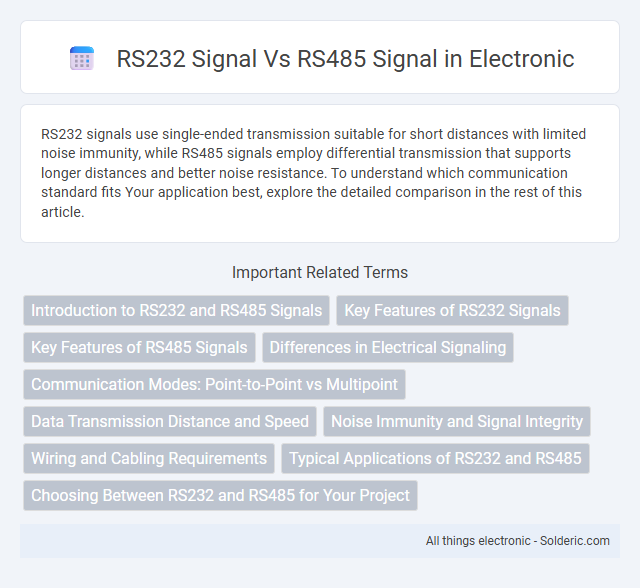RS232 signals use single-ended transmission suitable for short distances with limited noise immunity, while RS485 signals employ differential transmission that supports longer distances and better noise resistance. To understand which communication standard fits Your application best, explore the detailed comparison in the rest of this article.
Comparison Table
| Feature | RS232 Signal | RS485 Signal |
|---|---|---|
| Signal Type | Single-ended | Differential |
| Max Cable Length | 15 meters (50 feet) | 1200 meters (4000 feet) |
| Max Data Rate | 20 kbps (typical) | 10 Mbps (typical) |
| Number of Drivers | 1 Transmitter, 1 Receiver | Up to 32 Transceivers (multi-drop) |
| Communication Mode | Point-to-point | Multi-point (bus topology) |
| Signal Voltage Levels | +-3 to +-15 V | -7 to +12 V differential |
| Noise Immunity | Low, susceptible to noise | High, excellent noise rejection |
| Typical Application | Short-distance serial communication | Industrial networks, long-distance communication |
Introduction to RS232 and RS485 Signals
RS232 signal is a serial communication protocol primarily used for short-distance, point-to-point data exchange with single-ended signaling and voltage levels ranging from -15V to +15V. RS485 signal supports multi-point communication over longer distances using differential signaling, which enhances noise immunity and allows for multiple devices on the same bus. Understanding the differences in signal type and application helps optimize your system design for reliable data transmission.
Key Features of RS232 Signals
RS232 signals utilize single-ended transmission with voltage levels ranging from -15V to +15V, commonly designed for short-distance communication up to 15 meters. This standard supports point-to-point connections, typically using three to nine pins for data and control signals, and operates at lower data rates compared to differential signaling. RS232 signals are susceptible to electrical noise due to their single-ended nature, making them less suitable for industrial environments requiring long-distance or multi-drop networks.
Key Features of RS485 Signals
RS485 signals support differential signaling, enabling robust noise immunity and longer cable lengths up to 1,200 meters, making them ideal for industrial environments. Unlike RS232, RS485 can handle multi-point communication with up to 32 devices on a single bus, enhancing network scalability. Your choice of RS485 ensures higher data integrity and reliable transmission over complex wiring systems.
Differences in Electrical Signaling
RS232 signals use single-ended communication with voltage levels ranging typically from -15V to +15V, relying on a common ground reference, which limits cable length and noise immunity. RS485 signals operate using differential signaling with a voltage swing between two lines, enhancing noise resistance and allowing longer transmission distances up to 1200 meters. Your choice between RS232 and RS485 impacts system design based on required communication reliability and environmental electrical noise conditions.
Communication Modes: Point-to-Point vs Multipoint
RS232 signal supports point-to-point communication mode, allowing data exchange between two devices with a straightforward single-ended transmission. RS485 signal enables multipoint communication, permitting multiple devices to share the same bus through differential signaling, which enhances noise immunity and supports longer cable distances. Understanding these communication modes helps you select the appropriate protocol for your network topology and device count.
Data Transmission Distance and Speed
RS232 signals typically support data transmission distances up to 15 meters at speeds around 20 kbps, making them suitable for short-range communication. RS485 signals can transmit data over distances up to 1200 meters while maintaining speeds up to 10 Mbps at shorter distances, offering greater flexibility for industrial applications. Your choice between RS232 and RS485 should consider the required distance and speed for reliable data transfer in your system.
Noise Immunity and Signal Integrity
RS485 signals offer superior noise immunity compared to RS232 due to their differential signaling method, which effectively cancels out common-mode noise and allows longer cable lengths up to 1200 meters. RS232 uses single-ended signaling, making it more susceptible to electromagnetic interference and crosstalk, limiting its cable length to around 15 meters. The enhanced signal integrity of RS485 enables reliable data transmission in industrial and noisy environments, whereas RS232 is better suited for short-distance, low-noise applications.
Wiring and Cabling Requirements
RS232 signals typically use single-ended wiring with one transmit and one receive line, requiring a maximum cable length of about 15 meters with unshielded twisted pair cables. RS485 signals use differential signaling over twisted pair cables, enabling longer cable runs up to 1200 meters and supporting multiple devices on a single bus. Your choice between RS232 and RS485 wiring depends on the required distance, noise immunity, and network topology.
Typical Applications of RS232 and RS485
RS232 signals are typically used for short-distance, point-to-point communication in devices like computers, modems, and industrial equipment. RS485 signals excel in multi-point and long-distance communication, often employed in automation systems, building management, and networked sensor arrays. Your choice between RS232 and RS485 depends on the required communication length, noise immunity, and network complexity in your application.
Choosing Between RS232 and RS485 for Your Project
Choosing between RS232 and RS485 depends on your project's communication distance and environment; RS232 supports short-distance, point-to-point connections up to 15 meters, while RS485 enables long-distance, multi-point communication up to 1,200 meters. RS485 offers better noise immunity and supports differential signaling, making it ideal for industrial applications with multiple devices on a single bus. RS232 is simpler and widely used for direct device-to-computer interfaces where speed and distance requirements are minimal.
RS232 signal vs RS485 signal Infographic

 solderic.com
solderic.com